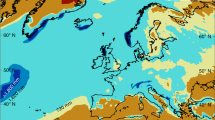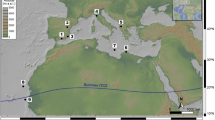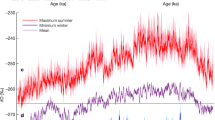Abstract
Climate in the Arctic region and northwestern Europe is strongly affected by the North Atlantic Oscillation1,2 (NAO), the dominant mode of atmospheric variability at mid-latitudes in the North Atlantic region. The NAO index is an indicator of atmospheric circulation and weather patterns: when the index is positive, Europe and the eastern US are mild and wet, whereas Greenland and northern Canada are cold and dry. A negative index is associated with the reverse pattern. Reconstructions of the NAO have so far been limited to the past 900 years3. Here we analyse a 5,200-year-long, high-resolution lake sediment record from southwestern Greenland to reconstruct lake hypolimnic anoxia, and link the results to an existing reconstruction of the NAO index from tree rings and speleothems3. Using the relationship between the two records, we find that around 4,500 and 650 years ago—around the end of the Holocene Thermal Maximum and the beginning of the Little Ice Age, respectively—the NAO changed from generally positive to variable, intermittently negative conditions. We suggest that variability in the dominant state of the NAO tend to coincide with large-scale changes in Northern Hemisphere climate. However, the onset of the Medieval Climate Anomaly was not associated with any notable changes in the NAO.
This is a preview of subscription content, access via your institution
Access options
Subscribe to this journal
Receive 12 print issues and online access
$259.00 per year
only $21.58 per issue
Buy this article
- Purchase on Springer Link
- Instant access to full article PDF
Prices may be subject to local taxes which are calculated during checkout




Similar content being viewed by others
References
Post, E. & Forchhammer, M. C. Synchronization of animal population dynamics by large-scale climate. Nature 420, 168–171 (2002).
Hinzman, L. D. et al. Evidence and implications of recent climate change in northern Alaska and other arctic regions. Climatic Change 72, 251–298 (2005).
Trouet, V. et al. Persistent positive North Atlantic oscillation mode dominated the Medieval Climate Anomaly. Science 324, 78–80 (2009).
Jevrejeva, S., Moore, J. C. & Grinsted, A. Sea level projections to AD2500 with a new generation of climate change scenarios. Glob. Planet. Change 80-81, 14–20 (2012).
Renssen, H. et al. Simulating the Holocene climate evolution at northern high latitudes using a coupled atmosphere-sea ice-ocean-vegetation model. Clim. Dynam. 24, 23–43 (2005).
Kaufman, D. S. et al. Recent warming reverses long-term Arctic cooling. Science 325, 1236–1239 (2009).
Seierstad, I. & Bader, J. Impact of a projected future Arctic Sea Ice reduction on extratropical storminess and the NAO. Clim. Dynam. 33, 937–943 (2009).
Box, J. E. Survey of Greenland instrumental temperature records: 1873–2001. Int. J. Climatol. 22, 1829–1847 (2002).
Strong, C., Magnusdottir, G. & Stern, H. Observed Feedback between Winter Sea Ice and the North Atlantic Oscillation. J. Clim. 22, 6021–6032 (2009).
Hurrell, J. W. & Deser, C. North Atlantic climate variability: The role of the North Atlantic Oscillation. J. Marine Syst. 79, 231–244 (2009).
Pausata, F. S. R., Li, C., Wettstein, J. J., Nisancioglu, K. H. & Battisti, D. S. Changes in atmospheric variability in a glacial climate and the impacts on proxy data: A model intercomparison. Clim. Past 5, 489–502 (2009).
Buehler, T., Raible, C. C. & Stocker, T. F. The relationship of winter season North Atlantic blocking frequencies to extreme cold or dry spells in the ERA-40. Tellus A 63, 212–222 (2011).
Appenzeller, C., Schwander, J., Sommer, S. & Stocker, T. F. The North Atlantic Oscillation and its imprint on precipitation and ice accumulation in Greenland. Geophys. Res. Lett. 25, 1939–1942 (1998).
Mosley-Thompson, E., Readinger, C. R., Craigmile, P., Thompson, L. G. & Calder, C. A. Regional sensitivity of Greenland precipitation to NAO variability. Geophys. Res. Lett. 32, L24707 (2005).
Vinther, B. M. et al. Climatic signals in multiple highly resolved stable isotope records from Greenland. Quat. Sci. Rev. 29, 522–538 (2010).
Walter, K. & Graf, H. F. The North Atlantic variability structure, storm tracks, and precipitation depending on the polar vortex strength. Atmos. Chem. Phys. 5, 239–248 (2005).
Engstrom, D. R. & Wright, H. E. in Lake Sediments and Environmental History (eds Haworth, E. Y. & Lund, J. W. G.) 1–68 (Leicester Univ. Press, 1984).
Davison, W. Iron and manganese in lakes. Earth Sci. Rev. 34, 119–163 (1993).
Mackereth, F. J. H. Some chemical observations on post-glacial lake sediments. Phil. Trans. R. Soc. B 250, 165–213 (1966).
D’Andrea, W. J., Huang, Y. S., Fritz, S. C. & Anderson, N. J. Abrupt Holocene climate change as an important factor for human migration in West Greenland. Proc. Natl Acad. Sci. USA 108 (2011).
Trouet, V., Scourse, J. D. & Raible, C. C. North atlantic storminess and atlantic meridional overturning circulation during the last millennium: Reconciling contradictory proxy records of NAO variability. Glob. Planet. Change 84–85, 48–55 (2012).
Mann, M. E. et al. Global signatures and dynamical origins of the Little Ice Age and Medieval Climate Anomaly. Science 326, 1256–1260 (2009).
Hurrell, J. W., Yochanan, K., Ottersen, G. & Visbeck, M. H. in The North Atlantic Oscillation: Climatic Significance and Environmental Impact Vol. 134 (eds Hurrell, J. W., Yochanan, K., Ottersen, G. & Visbeck, M. H.) 1–36 (AGU, 2003).
Cook, E. R., D’Arrigo, R. D. & Mann, M. E. A well-verified, multiproxy reconstruction of the winter North Atlantic Oscillation index since AD 1400. J. Clim. 15, 1754–1764 (2002).
Tiwari, R. K. & Srilakshmi, S. Periodicities and non-stationary modes in tree rings temperature variability record of the western Himalayas by multitaper and wavelet spectral analyses. Curr. Sci. India 97, 705–709 (2009).
Knudsen, M. F., Seidenkrantz, M-S., Jacobsen, B. H. & Kuijpers, A. Tracking the Atlantic Multidecadal Oscillation through the last 8,000 years. Nature Commun. 2, 178 (2011).
Knight, J. R., Allan, R. J., Folland, C. K., Vellinga, M. & Mann, M. E. A signature of persistent natural thermohaline circulation cycles in observed climate. Geophys. Res. Lett. 32, L20708 (2005).
Yang, D. & Myers, P. G. Impact of extended NAO buoyancy forcing on the subpolar North Atlantic and climate variability over the last millenium. Paleoceanography 22, PA3104 (2007).
Woollings, T., Gregory, J. M., Pinto, J. G., Reyers, M. & Brayshaw, D. J. Response of the North Atlantic storm track to climate change shaped by ocean-atmosphere coupling. Nature Geosci. 5, 313–317 (2012).
Vinther, B. M., Johnsen, S. J., Andersen, K. K., Clausen, H. B. & Hansen, A. W. NAO signal recorded in the stable isotopes of Greenland ice cores. Geophys. Res. Lett. 30, 1387 (2003).
Büntgen, U. et al. 2500 years of European climate variability and human susceptibility. Science 331, 578–582 (2011).
Acknowledgements
J.O. and M.F.K. were supported by the Carlsberg Foundation (Grants 2006_01_0451, 2007_01_0417 and 2008_01_0416). Fieldwork and collection of the local meteorological data was supported by a Danish Research Council award to N.J.A. (SNF: 21-00-0288).
Author information
Authors and Affiliations
Contributions
J.O. and N.J.A. designed the study. Fieldwork was undertaken by N.J.A., while J.O. did the primary data collection. J.O. and M.F.K. did the statistical analyses and all authors contributed to writing the manuscript.
Corresponding author
Ethics declarations
Competing interests
The authors declare no competing financial interests.
Supplementary information
Supplementary Information
Supplementary Information (PDF 1785 kb)
Rights and permissions
About this article
Cite this article
Olsen, J., Anderson, N. & Knudsen, M. Variability of the North Atlantic Oscillation over the past 5,200 years. Nature Geosci 5, 808–812 (2012). https://doi.org/10.1038/ngeo1589
Received:
Accepted:
Published:
Issue Date:
DOI: https://doi.org/10.1038/ngeo1589
This article is cited by
-
Drought as a possible contributor to the Visigothic Kingdom crisis and Islamic expansion in the Iberian Peninsula
Nature Communications (2023)
-
North Atlantic Oscillation impact on the Atlantic Meridional Overturning Circulation shaped by the mean state
npj Climate and Atmospheric Science (2023)
-
Possible climatically driven, later prehistoric woodland decline on Ben Lomond, central Scotland
Vegetation History and Archaeobotany (2023)
-
Iberian hydroclimate variability and the Azores High during the last 1200 years: evidence from proxy records and climate model simulations
Climate Dynamics (2023)
-
Paleohydrological changes during the Late Holocene recorded in the sediments of two mountain lakes in the Tatra Mountains (Central Europe)
Journal of Paleolimnology (2023)



